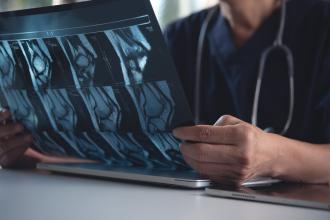Re: Radiologists as clinicians: Radiological interventions for knee osteoarthritis
I would like to thank the authors for covering platelet-rich plasma (PRP) as a treatment option for osteoarthritis in such detail [BCMJ 2024;66:159-164]. I have over 7 years of experience with PRP injections under ultrasound guidance for knees, shoulders, elbows, and other joints. The clinical importance of PRP was highlighted in a recent editorial commentary in Arthroscopy: The Journal of Arthroscopic and Related Surgery, “High-platelet-dose platelet-rich plasma may be the nonoperative treatment of choice for knee osteoarthritis.”[1]
Of course, there are still limitations and controversies, and one of the most important is the wide range in concentrations that are being used. As mentioned by the BCMJ authors, multiple studies have shown variation in platelet concentrations by over 18 times between different PRP preparations. This is analogous to varying the dose of a medication by a similar factor. No one would accept a study looking at the effect of a medication where the dose is not even mentioned, yet this happens routinely in studies involving PRP. I wrote about this in a letter to the Aesthetic Surgery Journal in response to one study involving PRP, which was actually platelet-poor plasma (the opposite of platelet-rich plasma), as shown by the independent analysis that the investigators had done on their PRP.[2]
Recent systematic reviews have demonstrated the importance of concentration and dose in PRP treatments, showing that high doses work better than lower ones. This was highlighted in a recent meta-analysis of 29 studies of PRP for knee osteoarthritis, which concluded that an average platelet dose of 5.5 billion showed a positive effect at 6 months, whereas a dose of 2.3 billion showed no effect.[3]
Unfortunately, most clinics are not aware of the concentration or dose they are providing to patients, or they may rely on the PRP kit manufacturer’s data to inform them. After testing many different PRP systems, we have found many manufacturers’ claims about concentrations to be greatly exaggerated. At our clinic, we use a hematology analyzer to check the concentration and composition of PRP on a daily basis for each treatment, documenting the concentration, dose, and composition of the PRP used for every patient. Unfortunately, such a practice seems to be very rare, and most clinics rely on manufacturer claims to estimate dose, which is often inaccurate. This often leads to patients trying what they think is PRP but seeing little if any clinical benefit. Even worse, platelet-poor plasma may have inhibitory effects on tissue regeneration, leading to undesired clinical outcomes.
I hope that awareness of PRP increases, along with attention to crucial factors such as measured concentration, dose, and composition, improving efficacy and clinical outcomes for our patients.
—Patrick Yam, MD, CCFP
Clinical Instructor, University of British Columbia
Owner and Physician, PRP Medical Aesthetics
Competing interests
Dr Yam owns the PRP Medical Aesthetics clinic, which provides private-pay PRP treatment.
This letter was submitted in response to “Radiologists as clinicians: Radiological interventions for knee osteoarthritis.”
hidden
 |
| This work is licensed under a Creative Commons Attribution-NonCommercial-NoDerivatives 4.0 International License. |
References
1. Hohmann E. Editorial commentary: High-platelet-dose platelet-rich plasma may be the nonoperative treatment of choice for knee osteoarthritis. Arthroscopy 2024. doi: 10.1016/j.arthro.2024.03.046.
2. Yam PK. The emperor has no platelets: Minimal effects in an alopecia split-scalp study unsurprising as platelet-rich plasma was actually platelet-poor. Aesthet Surg J 2022;42:NP365-NP367.
3. Berrigan WA, Bailowitz Z, Park A, et al. A greater platelet dose may yield better clinical outcomes for platelet-rich plasma in the treatment of knee osteoarthritis: A systematic review. Arthroscopy 2024. doi: 10.1016/j.arthro.2024.03.018.

